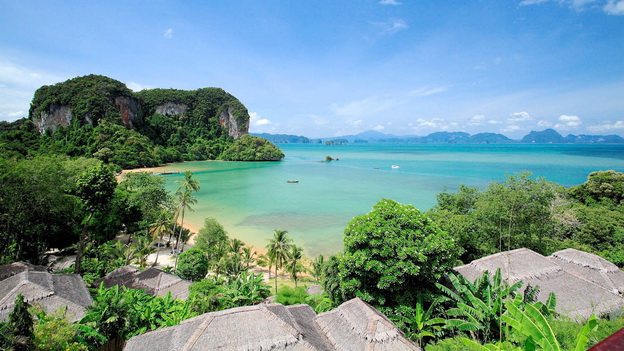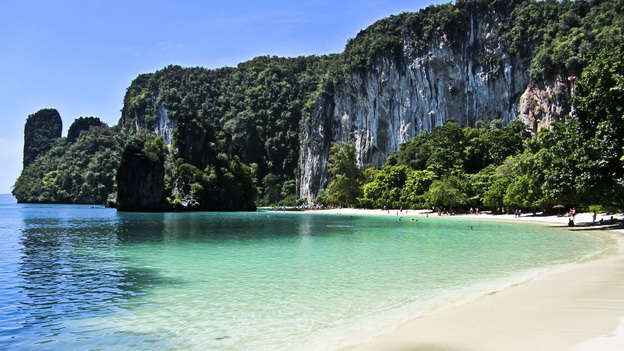October 15, 2015 / Lifestyle & Travel, News
In the second part of our cruising destination feature on Phang Nga bay we take you from the incredible Koh Chong Lat in the north along the east coast of Ko Yao Noi to the famous and popular Ko Hong Krabi in the south. With protected anchorages available in both seasons Phang Nga bay is a great all year round destination with plenty to explore. The island of Ko Chong Lat forms a large protected bay on its northeast side that offers great protection in all but the strongest of northeast winds. Anchor in the thick mud in around 15 metres being careful of the shallow water at the southern end of the bay. At mid tide and above you can take your tender two miles to the east around the Laem Sak headland to the Laem Sak seafood restaurant.

Leaving the anchorage via the south beware of the shallow reef just off the tip of the island which is shown on the charts. South of here you will find the islands of Ko Kudu Yai and Ko Kudu Noi. Anchor in the channel between the two islands in 5 to 8 metres. There are two great hongs on the larger island both of which can be accessed by dinghy. The southern one is very pretty while the one on the east coast is the home to a colony of giant fruit bats, which can be seen rising up from their roosts at dusk. Other wildlife includes monkeys, eagles, hornbills, kingfishers and large monitor lizards.
To the west of these islands is the pretty island of Ko Roi. Anchor on the west side of the island to the south of the rock stack in 10 to 12 metres. Do not attempt to pass between the rock stack and Ko Roi and do not approach close to the shore. Ashore there are two sandy beaches and a pretty hong accessible from the northwest beach on foot at low tide, in the dinghy at mid tide and by swimming in at all but the highest tides. Strong footwear is recommended. This is a great anchorage for lunch or a quiet overnight stop in the northeast season and is reasonably comfortable in the southwest.

At the north end of Ko Yao Noi is there are a couple of quiet bays before you reach the Paradise resort. This is a good spot which is sheltered in the SW season but not suitable overnight in the NE season. There is a very large reef in front of the beach that shelves extremely rapidly, filling the whole bay so anchor well off the beach in no less than 10 metres. Ashore the Paradise Ko Yao resort welcomes visitors, has a great restaurant and you can use the swimming pool. The large mud flat extending out from the beach makes access difficult at low water so look for the small wooden jetty at the Northern edge of the bay which has a channel leading to it marked by wooden sticks where you can leave your dinghy. There are well marked trails leading into the rain forest behind the resort.

Further south perched on the headland to the north of the rocky outcrop is the beautiful Six Senses hideaway spa and resort. You can eat ashore at the resort but we recommend you to book in advance to check availability by telephoning 076 418 500. At the north end of what is known as Long beach is the Ko Yao island resort with views over Pak Bia and Ko Hong. Another resort to the south is the simple buy good Holiday resort and further south is the Pyramid bar and restaurant and there are more small bars and restaurants around the rocky headland to the South. At the southern end of Ko Yao Noi in the entrance to the channel between it and Ko Yao Yai is the Laem Sai seafood restaurant which has a small if rather precarious floating pontoon where you can tie your tender but be careful not to fall into the fish pens!
Back out in the bay is the island group of Ko Pak Bia which has a good anchorage to the southwest of the sandy spit which joins two of the islands at low water. A little to the southeast on the north side of Ko Ka is a small bay which is a good lunch stop in calm conditions. It is too deep to anchor but there are a couple of mooring buoys off the small reef and a beach ashore. A little further to the south is the island of Ko Hong. The best anchorage to access the large hong that gives the island its name is on the north side in 15 to 20 metres being sure not to anchor on the coral. It is possible to enter the hong by dinghy over the shallow bar on tides over 2 metres and explore the lagoon, which at 200 metres across is one of the largest in the area. If there is not enough water to enter and leave the hong by dinghy you will need strong shoes, as the rocks are sharp with many sea urchins. On the southeast side of the island is a pretty bay with reasonably clear water suitable as a day stop or overnight in calm conditions. Beware of the fringing reef which shelves suddenly as you approach the beach and can be exposed at low water. Lots of mooring buoys have been laid but beware that the ones near to the beach are very close to the reef and are not suitable for yachts. There is a ranger station ashore and if you visit the beach you will be asked to pay a 200 baht per person per day National park entry fee.




September 4, 2015
Last month we featured the island of Langkawi, Malaysia, with details on the marinas and check in procedures. This month we give more of an…

June 28, 2015
With a large number of the private yachts in Thailand being registered in the port of Langkawi, Malaysia, many owners and boaters are familiar with…

May 28, 2015
In a meeting at the Phuket Provincial hall on May the 11th the Marine Department Director-General Chula Sukmanop outlined a four point approach to making…